One of the unique aspects of the 2021 NACS State of the Industry Summit were the six regional breakout sessions led by retailers who looked at geographic-specific SOI data for the leading categories in convenience sales.
The Northeast region, or Region 1, remained strong in 2021, posting higher profits than the national average with foodservice leading the way. Lisa Dell’Alba, president and CEO of Square One Markets, based in Bethlehem, Pennsylvania, gave an overview of the region’s performance.
In Region 1, total sales grew 32.3% year over year, with fuel sales up 45.7% and inside sales up 14%. While fuel consumption is up, it has yet to recover to reach 2019 levels. That could be because of reduced vacation traffic and a significant concentration of people working from home or participating in a hybrid model of work, said Dell’Alba.
Industry-wide total foodservice sales grew 18.2% year over year, reflecting demand for the fresh, on-the-go food that shoppers craved. Foodservice led Region 1 in-store gross profits with a 28.9% increase over 2020 and a 11.6% increase over 2019.
“In Region 1, this is our thing. This is what we do really, really well. We are masters at foodservice,” Dell’Alba said.
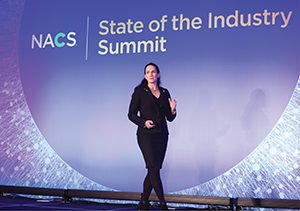 Lisa Dell'Alba, president and CEO, Square One Markets
Lisa Dell'Alba, president and CEO, Square One Markets
The region is second in the country for registered EVs (19.1%) as drivers in the Northeast have adopted EVs faster than other parts of the country, except for the West Coast (Region 6), which accounts for 54% of the entire U.S. EV fleet.
“Think of the state you are doing business in—does it need more chargers? There are still plenty of opportunities to serve our customers in a meaningful way in this area,” said Dell’Alba.
It is no surprise that direct store operating expenses skyrocketed in 2021. The problem is that operating expenses outpaced inside gross profit growth—increasing 21.8% year over year. Increases in DSOE were driven by familiar line items—wages and benefits and credit card swipe fees—which climbed 24% in the region last year compared with 2020.
Wages and benefits in total increased 12.6% over 2020. A relatively new line item in the wages and benefits section is other benefits, the line that generally holds expenses like training hours, employee retention and referral bonuses. Each component has increased since the beginning of the COVID-19 pandemic, which drove up already-high employee turnover.
In Region 1, this is our thing. We are masters at foodservice.
Wages specifically increased 9.7%, while other benefits grew 45.6% in 2021. Still, the additional spending did not slow employee turnover, where 70% of departures were voluntary quits, compared with 68.3% for the nation. While turnover increased for both manager (up 9.1 points) and non-manager (up 21.1 points) roles, Region 1 was still significantly lower than the national averages for both employee groups at 23% and 89.5%, respectively.
“People are really looking at what brings them value. People are looking for work that has meaning.
As employers, it’s our job to make sure our workers know our mission, and that they are essential to it,” said Dell’Alba.
SOUTHEAST
In Region 2, operating profit topped 2019, but the Southeast region, which includes Alabama, Florida, Georgia, Mississippi, North Carolina, South Carolina and Tennessee, faced some headwinds that most of the country also saw.
“2021 was a really good year for Region 2,” said Jon Rier, CFO of Refuel Operating Company, based in Mt. Pleasant, South Carolina. “Profits were driven by solid fuel performance, and we made great strides inside the store with foodservice. But on the flip side, there were some real challenges we faced like employee turnover and inflation.”
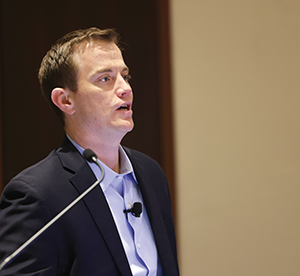 Jon Rier, CFO, Refuel Operating Company
Jon Rier, CFO, Refuel Operating Company
The average store operating profit per store, per month last year was up 9.3% over 2020 and up an impressive 66.4% over 2019; however, store operating profit in 2021 was down 7% in Region 2 compared with the national average.
The non-manager turnover rate was 181.3% in Region 2, which was up 44.1 percentage points over 2020 and up 38.6 points over 2019. Compared with the rest of the country, the non-manager turnover rate was 58.7 percentage points higher in Region 2.
“The national average [non-manager turnover rate] was high (122.6%), but it was a specific concern in our region,” said Rier. However, the manager turnover rate was 36% in Region 2, which was 9.79 percentage points lower than the national average.
Total direct store operating expenses for the average store in Region 2 were $60,080 last year—10.9% higher than in 2020 and 14.9% higher than in 2019. A major factor for the increase in direct store operating expenses was credit card fees, which rose 26.8% last year in Region 2.
MIDWEST
In Region 3, Art Sebastian, vice president of digital experiences, Casey’s, said “things are looking pretty positive” in the Midwest, and he is optimistic about where the industry is heading with its recovery from the pandemic.
Amid high turnover, an issue plaguing most industries across the United States, Region 3 financial performance measures were lower compared with the national average in 2021. However, when looking at the same financial measures on a year-over-year basis and comparing them to 2019, Region 3 is doing well from a financial standpoint.
 Art Sebastian, vice president digital expereinces, Casey's
Art Sebastian, vice president digital expereinces, Casey's
Region 3 store operating profit and EBITDA were up 13.3% and 13.4%, respectively, in 2021 compared with 2020, and substantially higher than 2019 (46.9% and 23.1%, respectively). Breakeven cents per gallon were down compared to 2020 (-24.7%) but slightly higher compared with 2019 (3.9%).
The total quit rate for this region surged in 2021 compared with 2020 and 2019. In 2021, the quit rate was slightly above the national average, which could be an indicator that there are more available job opportunities in Region 3 states compared to the rest of the country. Manager turnover was 69.5%, while non-manager turnover was 167.2%.
Sebastian noted that Casey’s began spending more time in exit interviews at the store level to find out why people choose to leave, and what they could do about it. One issue they heard was that the process for closing a store took too long, a signal that Casey’s could explore and implement time-saving measures that would help automate and streamline the tasks.
SOUTH CENTRAL
Overall, Region 4, which includes Arkansas, Louisiana, New Mexico, Oklahoma and Texas, performed below the national average, said Annie St. Romain Gauthier, CFO and co-CEO, St. Romain Oil Co.
Region 4 is still chasing the national average but gained lots of ground in 2021.
The average store operating profit per store, per month for Region 4 was $24,641 last year—43.3% lower than the national average, and EBIDTA per store on average was $17,914 last year in Region 4, which was 59% lower than the rest of the country.
A bright spot for Region 4 was that the manager turnover rate of 24.6% was 21.2 percentage points lower in 2021 than the national average of 45.8%.
“Despite generally performing below the national average, Region 4 showed improvement over the past two years, especially when we compare last year to 2019,” said Gauthier.
Average store operating profit per store, per month in Region 4 was up 14.8% last year compared with 2019. EBITDA per store, per month was up 21.7%, driving pretax profit in 2021 up 13.9% over 2019’s result.
Total all-sales per store, per month in Region 4 stood at $515,919 in 2021—up 41.4% compared with 2020 and up 14.2% compared with 2019. Fuel sales were at $370,092 per store, per month in 2021, which was a whopping 59.3% increase versus 2020 and up 13.8% compared with 2019.
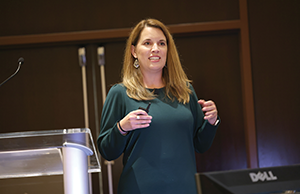 Annie St. Romain Gauthier, CFO and co-CEO, St. Romain Oil Co. and Y-Not Stop
Annie St. Romain Gauthier, CFO and co-CEO, St. Romain Oil Co. and Y-Not Stop
“Total sales growth was driven by fuel price, but inside sales growth was strong last year versus 2020 and 2019,” said Gauthier.
Average inside sales per store, per month in Region 4 last year were $148,687—up 11.2% compared with 2020 and up 14.% over 2019. The category leader within inside sales was foodservice, which averaged $29,128 per store, per month in 2021, up 17.4% versus 2020 and up 15.3% compared with 2019. Transactions were also up in Region 4 last year by 14.4% over 2020 and up 3.3% versus 2019.
“Region 4 is still chasing the national average but gained lots of ground in 2021,” said Gauthier.
CENTRAL
In the Central region, Stuart Taylor, vice president, Kum & Go, noted that comparing Region 5 metrics to the national level provides a good starting point for retailers to better understand their relative strengths and weaknesses.
The good news for Region 5 is that the workforce has largely returned to work and is outperforming the national average. Heading into 2021, the region, at roughly 4% unemployment, was lower than the national average and stayed that way throughout the remainder of the year, keeping a two-point lower gap versus the national average.
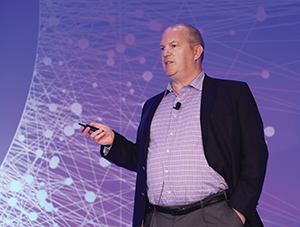 Stuart Taylor, vice president, Kum & Go
Stuart Taylor, vice president, Kum & Go
The total quit rate is also below the national average, but like Region 3, folks in Region 5 now have more choices than they had during the pandemic of where to work. “People held onto jobs when they didn’t know how secure they would be, but now we are seeing a market where employees have more choices than ever before,” Taylor said. The manager turnover rate was 24.1%, and the non-manager turnover rate was 112.3%.
“I challenge you, if you are not already doing so, to take a look at your separations and how they stack up,” said Taylor. “There is a lot to think on in terms of pay, benefits, childcare, etc. However, as the saying goes, people don’t quit bad jobs—they quit bad managers.”
Direct store operating expenses and facility expenses for Region 5 rose 10.1% in 2021 compared with 2020, and rose 16.8% compared with 2019. These expenses were driven by wages and benefits and swipe fees, which increased 26% in 2021 versus 2020.
Inside the store, prepared food and commissary were two bright spots within the foodservice segment. Prepared food gross profit increased 23% on a year-over-year basis, and commissary increased 54.9% year over year.
We have been taking advantage of California grants to build our own network of Level 3 EV charging locations.
WEST
In Region 6, c-store profits were shy of the national average, but staff turnover posted better than the national average, Varish Goyal, CEO, Loop Neighborhood Markets, based in Fremont, California, shared in the West regional breakout. Still, hiring and retaining staff remain a top issue for all retailers.
Region 6 makes up about 15.3% of the total c-store landscape in the U.S. C-store profits show lower numbers than the national average, with store operating profits 18.4% below the national average.
Although consumption has not returned to pre-pandemic levels, it has recovered significantly. Total sales grew 33.8% year over year, bolstered by fuel sales that grew four times the rate of 2020, up 44.5%. Fuel sales growth was driven by a 33.1% increase in average selling price. Inside sales showed a solid performance, up 6.5% year over year, and transactions bounced back, up 10.4% but still 5% off pre-pandemic levels.
The West leads the U.S. in terms of the number of registered electric vehicles. Registered EVs and EV sales were up 5% in 2021 in the region. This offers great opportunities for retailers to focus on customer charging needs and grow larger baskets, Goyal said.
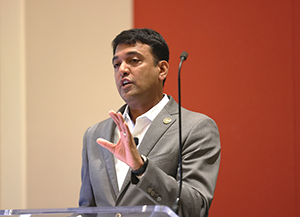 Varish Goyal, CEO, Loop Neighborhood Markets
Varish Goyal, CEO, Loop Neighborhood Markets
California represents 42% of the entire EV fleet nationally at 930,811 EVs registered, and Region 6 contributes 54% of the entire EV fleet at 1,159,650.
“As you look at the states in which you operate, there might be an opportunity to develop charging infrastructure where there are gaps,” said Goyal. “We have been taking advantage of California grants to build our own network of Level 3 EV charging locations.”
The race for EV charging will bring new competitors, indicated Goyal. Starbucks has partnered with Volvo and Charge Point to pilot EV charging stations in parking lots along a 1,350-mile stretch from Denver to Seattle. The route currently has few options for charging.
While charging times vary depending on the vehicle, longer dwell times are attractive for opportunities to drive inside sales. “Our opportunity is to find ways to keep drivers entertained or busy while their vehicles are charging,” Goyal said.
Staff turnover posted better than the national average; however, labor issues and retaining staff remain a top issue for all retailers. In Region 6, non-manager turnover of 111.2% was up slightly (four percentage points); however, at 40.5%, manager turnover was up 19.1 percentage points year over year.
Region 6 manager turnover is historically lower than the national average, but burnout from lean staffing and labor market conditions may have caused the gap to close to within five percentage points.